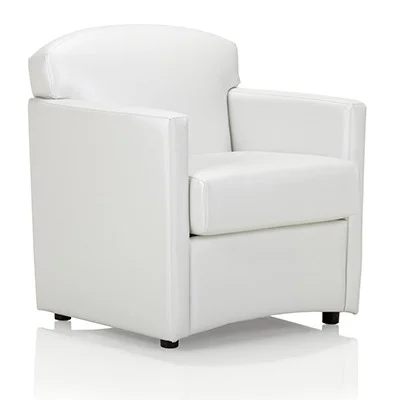
The Importance of Ergonomic Seating
Understanding the significance of ergonomic seating is crucial for anyone spending extended periods of time in a seated position, especially at work. This concept is not only important for comfort but also for health and productivity.
Defining Ergonomics
Ergonomics is the study of designing and arranging the things people use so that the people and things interact most efficiently and safely. In the context of seating, this refers to chairs that are designed to support the body’s natural alignment and movements, while reducing the risk of discomfort and injury.
An ergonomic chair typically features adjustable elements such as seat height, backrest angle, and armrests, allowing the chair to be customized to the individual’s body dimensions and work setup. More about this can be found in our article on ergonomic office chair.
The link between seating and work performance is more significant than one might initially realize. A chair that provides proper support can help reduce physical discomfort, which in turn can lead to increased focus, productivity, and overall work performance.
Studies have shown that employees who use ergonomic seating at work report less discomfort and perform tasks more efficiently compared to those who do not. The table below shows the impact of ergonomic seating on work performance.
| Aspect |
Improvement with Ergonomic Seating |
| Discomfort |
Decreased by 60% |
| Productivity |
Increased by 17.7% |
| Quality of Work |
Increased by 18.1% |
For a more detailed examination of how an ergonomic desk chair can enhance work performance, refer to our dedicated article.
Health Risks of Poor Seating
Poor seating choices can lead to a variety of health issues, particularly over long periods of use. These can range from minor discomforts such as back pain and muscle tension, to more serious conditions such as chronic musculoskeletal disorders and circulatory problems.
The health risks associated with poor seating include:
- Musculoskeletal Problems: Extended periods of sitting in a non-ergonomic chair can lead to musculoskeletal problems, such as back pain, neck strain, and carpal tunnel syndrome.
- Circulatory Issues: Sitting for long periods can also impact blood circulation, leading to swelling in the legs and feet.
- Reduced Metabolic Rate: Sitting for extended periods can lead to a slower metabolic rate, which can contribute to weight gain and related health issues.
Understanding the importance of ergonomic seating and implementing it in the workplace is a noteworthy step towards enhancing comfort, productivity, and overall health. To discover more about the various ergonomic seating solutions available, check out our comprehensive guide on ergonomic seating solutions.
Understanding Ergonomic Seating
Ergonomic seating is a crucial aspect of a comfortable and productive workspace. This section aims to detail the key characteristics of ergonomic chairs, their role in promoting good posture, and the impact of ergonomic seating on workplace productivity.
Key Features of Ergonomic Chairs
Ergonomic chairs are characterized by several distinct features designed to provide optimal support and comfort. These include:
Adjustable Seat Height: This allows users to position their feet flat on the floor, keeping thighs horizontal and arms at the height of the desk.
Seat Depth and Width: Adequate seat depth and width are necessary to support any user comfortably.
Lumbar Support: An ergonomic chair should have support for the lower back. Some chairs even have an adjustable lumbar support that allows the user to fit the chair to their lower back perfectly.
Backrest: An ergonomic chair should have a backrest that supports the natural curve of the spine.
Armrests: They should be adjustable and allow the user’s shoulders to relax.
Swivel: Any conventional desk chair should easily rotate so the user can reach different areas of their desk without straining.
Each of these features contributes to the overall comfort and functionality of ergonomic chairs, making them an ideal choice for individuals who spend a significant portion of their day seated at a desk.
How Ergonomic Chairs Improve Posture
Ergonomic chairs play an essential role in promoting good posture. The adjustable features of an ergonomic chair allow it to be customized to fit the user’s body, supporting the natural alignment of the spine and reducing the risk of back pain and musculoskeletal disorders.
The adjustability of seat height and depth, backrest angle, and armrest height allows users to maintain an upright posture with their feet flat on the floor and their knees at a 90-degree angle. This alignment reduces strain on the lower back, neck, and shoulders, promoting better overall posture.
Furthermore, the lumbar support provided by ergonomic chairs supports the natural inward curve of the lower spine, preventing slouching and reducing the risk of lower back pain. For more information on how ergonomic seating can improve posture, check out our article on ergonomic seating for posture.
Impact of Ergonomic Seating on Productivity
Investing in ergonomic seating can lead to noticeable improvements in workplace productivity. Comfortable employees are less likely to be distracted by discomfort and can focus more effectively on their tasks.
Moreover, ergonomic chairs reduce the risk of musculoskeletal disorders, which are a common cause of work-related absence. By reducing these risks, businesses can maintain a healthier, more consistent workforce.
A comfortable and supportive seating solution also demonstrates a company’s commitment to employee wellbeing, which can boost morale and job satisfaction.
In conclusion, the benefits of ergonomic seating extend beyond comfort, additionally contributing to improved posture and increased productivity. Implementing ergonomic seating solutions in the workplace can enhance employee wellbeing and lead to a more efficient, productive work environment.
The Science Behind Ergonomic Seating
The merits of ergonomic seating for work go beyond just comfort. An understanding of the science behind it reveals deep connections to body mechanics, injury prevention, and the psychology of comfort and productivity.
Ergonomics and Body Mechanics
Ergonomics is the study of how equipment and furniture can be arranged so that people can do work or other activities more efficiently and comfortably. Good body mechanics involve the coordinated effort of muscles, bones, and the nervous system to maintain balance, posture, and alignment during moving, transferring, and positioning tasks.
Ergonomic seating is designed with these principles in mind, promoting good body mechanics by supporting the body’s natural alignment. The backrest supports the natural curve of the spine, the seat height and depth accommodate different leg lengths, and the armrests are positioned to comfortably support the arms while allowing the shoulders to relax.
The Role of Ergonomics in Injury Prevention
Poorly designed seating can cause numerous health issues including back pain, neck tension, and repetitive strain injuries. Ergonomic seating for work is designed to prevent these types of injury by maintaining the natural alignment of the body and encouraging movement.
Ergonomic chairs have adjustable components that can be modified to fit the user’s body dimensions and work tasks. This adaptability makes it possible to maintain a neutral body position that reduces strain and eliminates awkward postures.
Furthermore, ergonomic seating often incorporates features that encourage dynamic sitting, promoting slight movements and shifts in posture that stimulate blood flow and reduce muscle fatigue.
The Psychology of Comfort and Productivity
Comfort and productivity are closely linked. Discomfort can be a major distraction, reducing concentration and negatively impacting work performance. Ergonomic seating contributes to a sense of physical comfort, which in turn creates a positive psychological state conducive to productivity.
When a worker is comfortable, they are less likely to be distracted by physical discomfort and more likely to be focused on their work. Moreover, by reducing the risk of musculoskeletal discomfort and injuries, workers are likely to have fewer absences and be more productive when they are at work.
A comfortable and well-supported worker is also more likely to feel valued by their employer, which can further boost morale and productivity. This is why investing in ergonomic seating solutions is not just a matter of physical health, but also an important element of a positive and productive work environment.
Implementing ergonomic seating in a work environment is a practical step towards boosting productivity and maintaining the health and well-being of employees. It’s a solution informed by science and backed by numerous studies. By understanding the science behind ergonomic seating, employers can make informed decisions that benefit both their employees and their organization as a whole.
Implementing Ergonomic Seating at Work
Implementing ergonomic seating for work is a crucial step in promoting a healthier, more productive workplace. It begins with assessing the current seating situation, choosing suitable ergonomic chairs, and fostering ergonomic practices among the workforce.
Assessing Your Current Seating Situation
Before making any changes, it’s important to understand the current seating arrangement and how it impacts the employees’ comfort and productivity. This includes evaluating the type, age, and condition of the chairs, as well as observing how employees interact with them.
Consider factors such as the duration of sitting, posture while working, and any discomfort or pain that employees report. This assessment will provide a clear picture of the changes needed to improve the seating environment. It will also inform the selection process for new ergonomic chairs.
Considerations for Selecting Ergonomic Chairs
Choosing the right ergonomic chair is crucial for ensuring the comfort and health of employees. Here are some key features to consider when selecting ergonomic chairs:
Adjustability: Look for chairs that offer adjustable seat height, depth, and tilt, as well as customizable armrests and backrests. This allows each employee to tailor the chair to their individual needs.
Lumbar Support: A good ergonomic chair should offer adequate lumbar support to maintain the natural curve of the spine and prevent slouching.
Material and Padding: The chair should be padded for comfort and upholstered in a breathable material to prevent overheating.
Swivel and Mobility: Chairs that swivel and have wheels allow for easy movement and can prevent strain from reaching or twisting.
It’s worth exploring our guides on ergonomic office chair and ergonomic desk chair for further information.
Encouraging Ergonomic Practices among Employees
Once the ergonomic chairs are in place, it’s crucial to educate employees about their benefits and how to use them correctly. This can be achieved through training sessions, informative handouts, or one-on-one coaching.
Encourage employees to adjust their chairs to suit their body dimensions and workstation setup. They should be advised to maintain a good posture, with their feet flat on the ground, knees at a 90-degree angle, and backrest supporting the natural curve of the spine.
Finally, remind employees of the importance of taking regular breaks from sitting. This can be facilitated by promoting activities such as standing meetings, stretch breaks, or walking sessions.
By implementing ergonomic seating for work, companies can promote healthier working conditions, boost employee satisfaction, and ultimately enhance productivity. Explore our resources on ergonomic seating solutions for more insights.
Maintaining and Maximizing Your Ergonomic Seating
Once you’ve implemented ergonomic seating for work, it’s crucial to maintain and maximize its benefits to continue enjoying improved comfort and productivity. This involves adjusting your chair to achieve optimal comfort, regular maintenance and cleaning, and balancing seating with movement and stretching.
Adjusting Your Chair for Optimal Comfort
Optimal comfort is one of the benefits of ergonomic seating, but it requires correct adjustment of the chair. Start with adjusting the chair’s height so that your feet rest flat on the ground, and your knees are at a 90-degree angle. Your elbows should also be at a 90-degree angle when typing, with your wrists straight.
The backrest should support the natural curve of your spine, reducing the stress on your lower back. Ensure the chair’s recline tension is adjusted to allow comfortable leaning without straining.
Here is a quick reference guide to chair adjustments:
| Chair Adjustment |
Ideal Position |
| Height |
Feet flat on the ground, knees at 90 degrees |
| Armrests |
Elbows at 90 degrees, wrists straight |
| Backrest |
Supports natural spine curve |
| Recline Tension |
Allows comfortable leaning without straining |
Regular Maintenance and Cleaning
Regular maintenance and cleaning of your ergonomic chair extends its lifespan and ensures it continues to provide the necessary support and comfort. Check for any loose screws or parts and tighten them as needed. Clean the chair regularly to keep it free from dust and allergens. If the chair has a fabric cover, vacuum it regularly and clean any stains promptly to prevent long-term damage.
Balancing Seating with Movement and Stretching
While ergonomic seating significantly improves comfort and reduces the risk of musculoskeletal disorders, it’s still important to balance seating with movement and stretching. Regular breaks from sitting, such as standing or walking for a few minutes every hour, can alleviate any potential strain caused by prolonged sitting. Incorporate stretching exercises into your routine to promote circulation and flexibility.
| Activity |
Frequency |
| Stand or Walk |
Every hour |
| Stretching Exercises |
Twice a day |
Remember, the goal of ergonomic seating is to promote comfort and enhance productivity. By maintaining your chair, adjusting it for optimal comfort, and balancing seating time with movement and stretching, you can maximize the benefits of your ergonomic seating for work.















; ?>/theme/img/ecl.jpg)